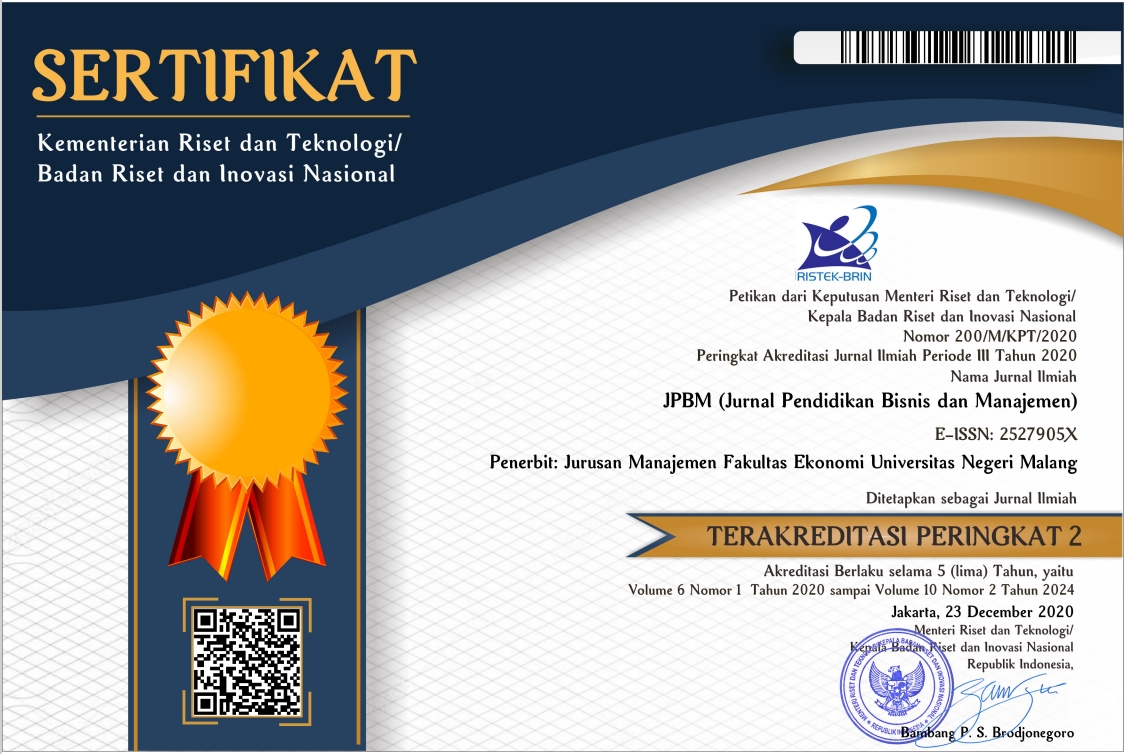Developing Instructional Media Mobile Learning Based Android to Improve Learning Outcomes
Abstract
This research aims to develop instructional media which is tested its feasibility and piloted in learning activities. The instructional media is developed using online builder Appypie with DCE developed-model. The product assessment is conducted by material expert, media expert and testing in a small and big group.The instrument of collected data is conducted by interviewing, questionnaire and test. The results of this research are: The instructional media product, mobile learning based android, has been using online builde Appypie, instructional media is feasible to apply after obtaining assessment result from material and media expert and users, The learning outcomes increases significantly between students with and without using instructional media. In summary, developed instructional media is feasible to app;y in a learning activity.
Keywords
Full Text:
PDFReferences
Biard, N., Cojean, S., and Jamet, E. 2017. Effects of segmentation and pacing on procedural learning by video. Computers in Human Behavior. 49, 411-417. https://doi.org/10.1016/j.chb.2017.12.002
Büyükbaykal, C.I. 2015. Communication technologies and education in the information Age. Procedia Social and Behavioral Sciences.174, 636 – 640. https://doi.org/10.1016/j.sbspro.2015.01.594
Chen, C.P. 2018. Understanding mobile English-learning gaming adopters in the self-learning market: The Uses and Gratification Expectancy Model. Computers & Education. 126, 217-230. https://doi.org/10.1016/j.compedu.2018.07.015
Emran, M.A., Elsherif, H.M., Shaalan, K. 2016. Investigating attitudes towards the use of mobile learning in higher education. Computers in Human Behavior. 56, 93-102. https://doi.org/10.1016/j.chb.2015.11.033
Gan, B., Menkhoff, T., and Smith, R. 2015. Enhancing students’ learning process through interactive digital media: New opportunities for collaborative learning. Computers in Human Behavior. 51, 652-663. https://doi.org/10.1016/j.chb.2014.12.048
Hamidi, H., and Chavoshi, A. 2018. Analysis of the Essential Factors for the Adoption of Mobile Learning in Higher Education: A Case Study of Students of the University of Technology. Telematics and Informatics. 35, 1053-1070. https://doi.org/10.1016/j.tele.2017.09.016
Hunaiyyan, A.A., Alhajri, R.A., Sharhan, S.A. 2018. Perceptions and challenges of mobile learning in Kuwait. Journal of King Saud University – Computer and Information Sciences 30(2), 279–289. https://doi.org/10.1016/j.jksuci.2016.12.001
Jeno, L.M., Grytnes, J.A., and Vandvik, V. 2017. The effect of a mobile-application tool on biology students' motivation and achievement in species identification: A Self-Determination Theory perspective. Computers & Education. 107, 1-12. https://doi.org/10.1016/j.compedu.2016.12.011
Miloševic, I., Zˇivkovic´, D.,Manasijevic´, D., and Nikolic´, D. 2015. The effects of the intended behavior of students in the use of M-learning. Computers in Human Behavior. 51, 207–215. https://doi.org/10.1016/j.chb.2015.04.041
Nasir, A.R., and Bargstädt, H.J. 2017. An approach to develop video tutorials for construction tasks. Prodecia Engineering. 196, 1088-1097. https://doi.org/10.1016/j.proeng.2017.08.066
Nayak, J.K. 2018. Relationship among smartphone usage, addiction, academic performance and the moderating role of gender: A study of higher education students in India. Computers & Education. 123, 164-173. https://doi.org/10.1016/j.compedu.2018.05.007
Naz, A.A., and Akbar, R.A. 2008. Use of Media for Efeective Instruction its Importance: Some Consideration. Journal of Elementary Education A Publication of Deptt. of Elementary Education. 18, 35-40.
Ozdamlia, F., and Cavus, N. 2011. Basic elements and characteristics of mobile learning. Procedia Social and Behavioral Sciences. 28, 937 – 942. https://doi.org/10.1016/j.sbspro.2011.11.173
Parsazadeh, N., Ali, R., and Rezaei, M. 2018. A framework for cooperative and interactive mobile learning to improve online information evaluation skills. Computers & Education. 120, 75-89. https://doi.org/10.1016/j.compedu.2018.01.010
Sangsawang, T. 2015. Instructional design framework for educational media. Procedia Social and Behavioral Sciences. 176, 65 – 80. https://doi.org/10.1016/j.sbspro.2015.01.445
Taleb, Z., Ahmadi, A., and Musavi, M. 2015. The Effect of M-learning on Mathematics Learning. Procedia Social and Behavioral Sciences. 171, 83-89. https://doi.org/10.1016/j.sbspro.2015.01.092
Tan, W.K., Hsiao, Y.J., Tseng, S.F., and Chan, C.L. 2018. Smartphone Application Personality and Its Relationship to Personalities of Smartphone Users and Social Capital Accrued through Use of Smartphone Social Applications. Telematics and Informatics. 35 (1), 255-266. https://doi.org/10.1016/j.tele.2017.11.007
Teodorescu, A. 2015. Mobile learning and its impact on business English learning. Procedia - Social and Behavioral Sciences. 180, 1535 – 1540. https://doi.org/10.1016/j.sbspro.2015.02.303
Vebrianto, R. and Osman, K. 2011. The effect of multiple media instruction in improving students’ science process skill and achievement. Procedia Social and Behavioral Sciences. 15, 346–350. https://doi.org/10.1016/j.sbspro.2011.03.099
DOI: http://dx.doi.org/10.17977/um003v4i32018p117
Refbacks
- There are currently no refbacks.
JPBM (Jurnal Pendidikan dan Bisnis Manajemen) is licensed under a Creative Commons Attribution-NonCommercial-ShareAlike 4.0 International License.
JPBM (Jurnal Pendidikan dan Bisnis Manajemen) is abstracted and indexed in :
















